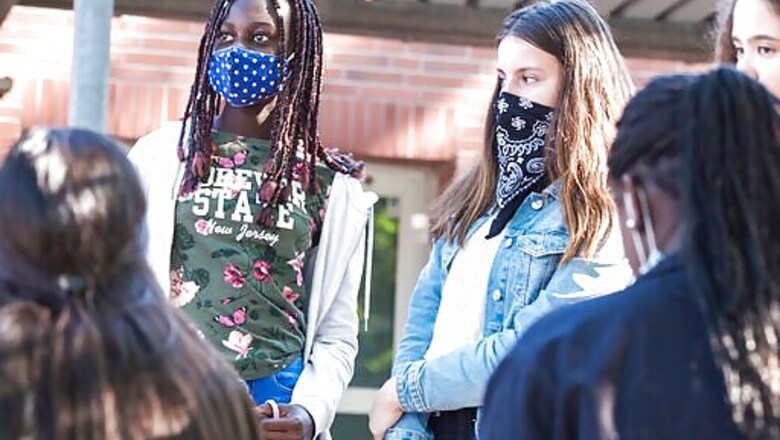
views
BERLIN Masks during class, masks only in the halls, no masks at all. Distance when possible, no distance within same-grade groups, no distance at all.
As Germanys 16 states start sending millions of children back to school in the middle of the global coronavirus pandemic, the countrys famous sense of Ordnung has given way to uncertainty, with a hodgepodge of regional regulations that officials acknowledge may or may not work.
There cant, and never will be 100% certainty, said Torsten Kuehne, the official in charge of schools in Pankow, Berlins most populous district where 45,000 students go back to school Monday. We are trying to minimize the risk as much as possible.
Germany has won plaudits for managing to slow the spread of the coronavirus quickly, efficiently and early, but the opening of schools is proving a new challenge as the country struggles to balance the concerns of anxious parents and children, skeptical scientists, worried teachers and overtaxed administrators.
With U.S. President Donald Trump pushing for American schools to reopen in person and on time even as the country nears 5 million confirmed coronavirus cases, and other countries moving ahead with plans to resume classes despite rising infections, many eyes are on the real-life experiment offered in Germany to see what works and what doesn’t.
The U.N. said this week that as many as 100 countries have yet to announce a date for schools to reopen, and Secretary-General Antonio Guterres warned of a possible generational catastrophe in education. He urged that restarting school be made a top priority once countries have the coronavirus under control.
Germany has seen some 217,000 confirmed cases and 9,200 deaths, and brought down a peak of some 6,000 new daily infections in March to the low hundreds. Numbers have been creeping back up, however, and topped the 1,000 per day mark in recent days for the first time in about three months.
Israel attempted a full reopening in May, at a time when the coronavirus was widely thought to have been beaten in the country, only to suffer new outbreaks that led to schools being shut down again and a surge in the spread of the virus nationwide. In South Africa, four grade levels were restarted in June but then closed back down when the country’s virus cases surged.
As Berlin prepares to send its nearly half-million students back to school on Monday, many fear something similar could happen.
The concerns are enormous, because the schools are hotspots, said Doreen Siebernik, who heads the Berlin branch of the GEW teachers union. “I know that there are pupils coming to school who have contact with hundreds, with thousands of people every day.
Berlins plan includes requiring students – and teachers – to wear masks in hallways, but not during instruction or in the playground. Sports, music and drama will be allowed, but with restrictions, like requiring choir members to keep at least 2 meters from one another.
Berlins minister for education Sandra Scheeres said its not possible in a school to always keep students 1.5 meters (5 feet) from one another, but that the distance should be kept if feasible. Students are to be kept in cohorts groups that should not mix so that if there is an outbreak, only those affected would need to be quarantined.
The state government recommends those groups don’t mingle outside school either, but it was not clear how that could be enforced.
“There are conflicting priorities, health protection on the one hand , which is very important to us, and on the other hand that we want to ensure the right to education of every single child, Scheeres said.
A Berlin Institute of Technology study on coronavirus transmission concluded that classrooms should be ventilated for a full 15 minutes every half hour. Scheeres’ current plan calls for windows to be opened following each 45 minute class.
Dr. Isabella Eckerle, head of the emerging viruses research group at the University of Geneva, said there was still a lot to learn about how children are affected by the coronavirus and transmit it, but that it was clear from school openings in other countries they could spark wider outbreaks.
If we go back to the normal school day now clinging to wishful thinking that children do not play a role in the pandemic, that will come back to haunt us, she said. Instead of ideologically charged discussions, we need pragmatic concepts to get us through the winter.
In a sharply-worded open letter to Scheeres and the citys mayor, Marco Fechner, a father of two and parent representative in the Pankow district, noted that many classroom windows don’t open, and that the government has stricter mask rules for supermarkets and its own offices than schools.
He urged the administration to focus more resources to permit some learning from home, so that class sizes and contact could be kept to a minimum.
This decision is absolutely incomprehensible to me as a father, and I fear for the health of my children and our relatives, Fechner wrote.
Similar concerns are playing out elsewhere, like in Scotland where schools also are due to reopen on Tuesday. There is uncertainty about whether measures to increase hand washing and social distancing with limited mixing between classroom groups but no mandatory masks will work.
Berlins back-to-school guidelines are middle-of-the-road among German states.
The first students to return, in the northeastern state of Mecklenburg-Western Pomerania, had no mask requirement but the cohort principle was in place and the education minister said mask regulations were in the works. In a worrisome sign, two schools were temporarily closed Friday after new cases of coronavirus were detected.
Students over age 10 who returned to school in Hamburg on Thursday were required to wear masks, but could take them off once seated in classrooms.
In Germanys most populous state, North Rhine-Westphalia, 2.5 million students face the countrys strictest measures as they return on Wednesday, including a mask requirement while in class.
Federal Health Minister Jens Spahn said Germany’s staggered returns and different approaches will help determine what works and what doesn’t.
Meantime, schools and districts have been improvising their own solutions to conform with voluminous government guidelines.
In Berlin’s Pankow, Kuehne has been talking with school lunch suppliers all summer to work out a plan to serve meals at staggered times, and in classrooms, to avoid large groups in the cafeteria.
I wouldn’t say I’m worried, but I see the very, very big challenges ahead of us as school authorities, schools and parents,” he said.
____ AP reporters Josef Federman in Jerusalem; Jill Lawless in London; Mogomotsi Magome in Johannesburg and Dorothee Thiesing, Frank Jordans and Kirsten Grieshaber in Berlin contributed to this story. ____ Follow AP pandemic coverage at http://apnews.com/VirusOutbreak and https://apnews.com/UnderstandingtheOutbreak
Disclaimer: This post has been auto-published from an agency feed without any modifications to the text and has not been reviewed by an editor




















Comments
0 comment